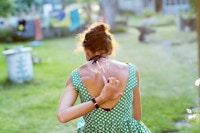Scabies
Scabies is a skin disease caused by scabies mites that dig deep into the skin and lay eggs.
Scabies is most common in young adults, but is also seen in children and the elderly.
-
Symptoms
Scabies is a skin disease caused by scabies mites that dig deep into the skin and lay eggs. Typical of this condition is that you suddenly get a troublesome itching, which is most intense after lying down under the duvet. The itching is strongest in places where the scabies mite is found, but the itching eventually affects the whole body. The head and neck are usually free of infection and itching. Most people develop itchy, red dots, occasionally small blisters, and eventually crusts as a result of the itching.
Scabies often becomes visible. These are greyish white, thin and serpentine and can be from one to two millimeters and up to ten millimeters long. The mite can be seen as a black dot at the end of the scabies, but it can also be very difficult to detect. The scabies can be found most easily on the side of the fingers, around the wrist and in the elbows, possibly around the nipples or on the skin of the penis and scrotum. On the genitals you often get small, red and hard nodules. In children under the age of two, scabies can often be seen in the soles of the feet.
Scabies infection has probably increased in Norway in recent years. Scabies is most common in young adults, but is also seen in children and the elderly.
-
What can I do myself?
It is crucial to get rid of any scabies mites that may be in the house. Scabies mites will die after two to four days without skin contact. Bed linen, towels and clothes that have been close to the skin must be washed at 60 degrees. Clothes that do not tolerate this can be hung away for a week, or placed in a freezer overnight. Larger garments and outerwear, duvets, blankets, pillows and mattresses are well ventilated and cool and put away.
Cabinet infection is treated with Nix cream. The entire skin surface of your arms and legs, your abdomen, chest and back, your external genitalia and your seat should be lubricated. Remember to lubricate well also between fingers and toes, in armpits and navel.
Head and face: In adults and children over the age of two, the head and face are only lubricated by visible scabies attacks in these areas. In the elderly and children under the age of two, the neck, face, ears and scalp should also be lubricated, but avoid the area around the eyes and the area around the mouth where the cream can be licked off. After at least 12 hours (max. 24 hours) you should shower or bathe. If you have washed your hands before eight hours have passed, your hands should be lubricated again. In addition to the patient, all family members and close contacts must be treated, even if they do not have itching, rashes or other signs of infection. The treatment should be done at the same time for everyone. Even if the treatment is successful, the itching may persist for up to four to six weeks. A cortisone ointment will be able to alleviate this itching. Nix cream can also be used by pregnant, breastfeeding and children up to two months of age. In the absence of a treatment effect, there are other alternatives. The risk of infection ceases quickly during treatment. The children can therefore go to school / kindergarten the day after the treatment has started. -
What can Eyr help with?
- Eyr can help make a diagnosis
- Eyr can prescribe medicine for scabies
- Eyr can prescribe medicine for itching
- Eyr can advise on necessary measures to prevent infection and re-infection
Download Eyr on your mobile and book an appointment now
Have a video call with a doctor - when and where it suits you. Download the app and book a doctor's appointment or vaccine now.

Reference: Norwegian Medical Handbook, NEL. Edited and medically quality assured by Dr. Theresa Franck, specialist in general medicine.
